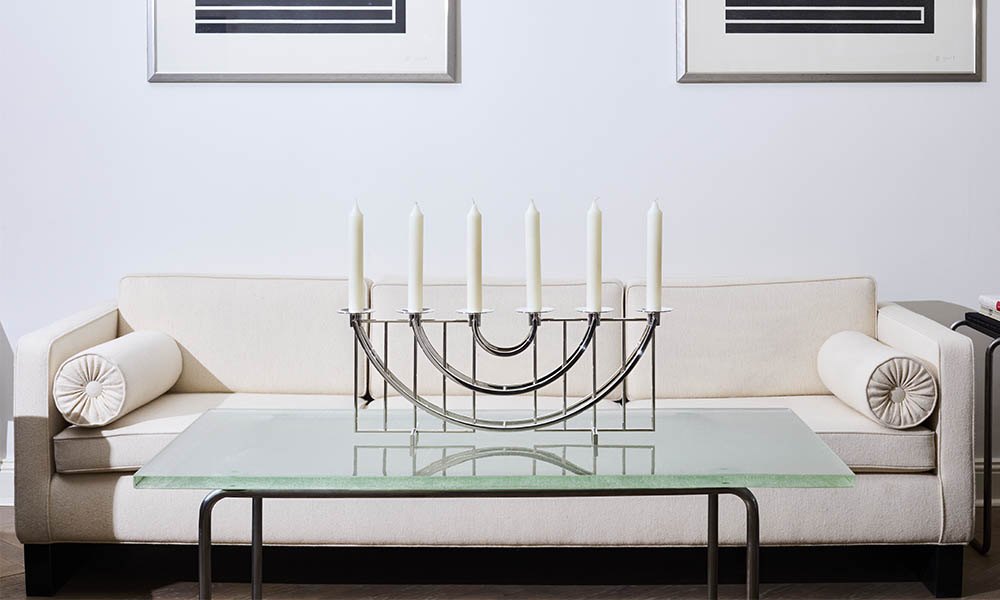
The Benefits of Dining with Silver
Silver is a beautiful as well as timeless material and like other noble materials, utilized in the fabricating of silverware can create memorable dining.
Silver is a precious natural metal that has been used to create tableware, cutlery and vessels for centuries. Exclusively worked silver tableware intended for use has been created in different regions of the globe since Antiquity. For example, throughout the Roman Empire during banquets, food and wine was served in silver vessels. And until the emergence of porcelain in Europe (Meissen, Germany, beginning of 18th c.), silver was used to serve food and liquid. Silver has been essential not only for its aesthetic beauty, historic merit, investment value, but also for its health benefits. The fact is silver is an antiseptic metal, which contributes naturally to improving our health.
Civilized diners nourish themselves with all five senses. Smell, touch and taste are obvious components of a refined dining experience. Hearing the sound of a silver spoon in a porcelain cup creates magic to our hearing sense. This brings us to the sense of seeing. Upon entering a dining area, we are struck visually with an appealingly irresistible table setting, or what one would hope to be “a feast for the eyes.” A proper table setting is an art in itself; one that includes silver cutlery, even if the silverware pattern is antique or considered unfashionable, it makes no difference if an aesthetic and cultivated presentation is preserved. In fact, today it has become a personal fashion statement to mix and match new and old cutlery, or cutlery with modern plates or old plates with contemporary cutlery.
Instead of using stored antique or family silver only on special occasions, I recommend spending the time to polish the rarely used silverware to its forgotten brightened shine and decorum. Once properly polished, put the heirloom cutlery to everyday use. This allows participants to discuss and delve into the history of a particular silver set or pattern, lively anecdotes of your family’s or recently purchased new silverware. Silverware can become the discussion for its visual aesthetic beauty, distinction and/or one that contributes to stimulating all the senses. In addition, utilizing one’s silverware regularly diminishes its tarnishing, because the pieces being handled are at the same time being polished during use. The natural shine of silver, a unique patina with a warm luster, will continue to show through with time and regular use.
While being sustainable, silverware has longevity and continues to appreciate in value Silverware is created for generational use and has a history of being put into service for centuries. A silver service is more than not often a lifetime acquisition and an important investment that gives the owner considerable added value, in addition to aesthetic beauty and longevity.
At Robbe & Berking, we value sustainability as much as tradition and heritage. An unspoiled environment and the preservation of biodiversity through less resource consumption are important. Hence, Robbe & Berking recycles all damaged and returned silver products by melting down old silver and reworking it into new sheet metal to be used in new manufacturing.
Hippocrates of Kos (460-370 B.C.), known as the founding father of Western medicine, wrote about the healing and hygienic benefits of silver. He used the bioactivity of silver for preparations of ulcer treatment and to promote the healing of wounds. In fact, silver has been widely applied in medicinal use worldwide. Silver has been proven to stimulate new cell growth and therefore is found it in everyday products, such as patches, creams, water- and air-filters etc.
Unlike other metals, silver has an inherent property – it’s antibacterial - that prevents the buildup of bacteria cells in its chemical bonds, inhibiting bacteria from surviving and thriving, which makes it beneficial to use silver cutlery for eating. This aspect of silver has convinced many health-conscious people to use silverware daily. Utilizing silver cutlery has once again become a habit to foster good health.
Staying healthy during the past two years of the covid-19 pandemic has become the most important issue of our lives. Over these past twenty-five months we have lived in a particularly sensitive health-period. Although silver is no cure for viruses, dining with silverware contributes naturally to an antibacterial daily routine instead of dining with stainless steel cutlery or any other material than silver.
Providing a healthy lifestyle through nourishing our bodies with healthy foods, making sure we have enough exercise and sleep, similarly dining with silver or silver-plated cutlery fosters the same benefits. It has been proven: Daily dining with silverware helps prevent anti-inflammatory diseases, boost our immune system, and improve our metabolic system. In short, dining with silverware has health and healing powers.
Silver Wonder Properties
Furthermore, silver is a non-toxic substance. It does not cause cancer or any neurological diseases or damage, unlike other carcinogenic materials such as plastics, synthetics, and many other metals (i.e. aluminum, lead, beryllium etc.).
As a wasteful society, we often depend on disposable utensils made of plastic or synthetic material that include phthalates and bisphenol A (BPA), harmful additives that can leak in hot conditions into our food and cause diseases, such as hormonal imbalances and various types of cancer.
There are no harmful additives in silver and silver cutlery is the healthiest alternative to all other cutlery available on the market. Silverware doesn’t need to be sterilized unlike synthetic or plastic utensils because of this anti-bacterial property. Silver helps prevent bacteria from entering our body, and has the ability to fight the antibiotic-resistant super-pathogens.
To avoid disposable utensils, I have purchased a personalized Robbe & Berking set of silver cutlery, a five piece place setting in a portable canvas roll. When I travel and need to eat on the go, my meal becomes a healthy beautiful feast. More health-conscious people are now traveling with their personalized sets of four, six or eight pieces of cutlery.
Easy Silver Care
Robbe & Berking’s silver cutlery is easy to maintain as it can be put in a dishwasher and never requires high maintenance.
Hot water with minimal PH-neutral dish soap is sufficient for cleanliness.
Having an engraved set of Robbe & Berking silverware for daily use is special and even taking the time to polish your personal set twice a year gives one the knowledge of possessing timeless beauty that is universal.
- Barillo, David J., David E. Marx: Silver in medicine: A brief history BC 335 to present, Volume 40, Supplement 1, 2014. Chopra, I. (2007) The increasing use of silver based products as antimicrobial agents; a useful development or cause for concern. J Antimicrob Chemother 59, 587– 590.
- Engin AB, Engin A. The effect of environmental Bisphenol A exposure on breast cancer associated with obesity. Environ Toxicol Pharmacol. 2021 Jan;81:103544. doi: 10.1016/j.etap.2020.103544. Epub 2020 Nov 5. PMID: 33161112.
- Gao, Hui MD; Yang, Bao-Jun MD; Li, Nan MD; Feng, Li-Min MD; Shi, Xiao-Yu MS; Zhao, Wei-Hong MD; Liu, Si-Jin PhD Bisphenol A and Hormone-Associated Cancers, Medicine: January 2015 - Volume 94 - Issue 1 - p e211 doi: 10.1097/MD.0000000000000211
- Khan, N.G., Correia, J., Adiga, D. et al. A comprehensive review on the carcinogenic potential of bisphenol A: clues and evidence. Environ Sci Pollut Res 28, 19643–19663 (2021). https://doi.org/10.1007/s11356-021-13071-w
- Laughlin Z, Conreen M, Witchel HJ, Miodownik M. The use of standard electrode potentials to predict the taste of solid metals. Food Qual Prefer. 2011;22:628–37.
- McGee, H. Q&A: Harold McGee, the curious cook. Flavour 2, 13 (2013). https://doi.org/10.1186/2044-7248-2-13
- Nadworthy, P.L., Wang, J., Tredget, E.E. and Burrell, R.E. (2008) Anti-inflammatory activity of nanocrystalline silver in a porcine contact dermatitis model. Nanomedicine 4, 241– 251.
- Ninan, Neethu, Nirmal Goswami, and Krasimir Vasilev. 2020. "The Impact of Engineered Silver Nanomaterials on the Immune System" Nanomaterials 10, no. 5: 967. https://doi.org/10.3390/nano10050967
- Oliver, Andrew, and John Shelton. "Silver on Papyrus: A Translation of a Roman Silver Tableware Inventory." Archaeology 32, no. 1 (January–February 1979), pp. 21–28.
- Owens, B. Silver makes antibiotics thousands of times more effective. Nature (2013). https://doi.org/10.1038/nature.2013.13232
- Raff, Katharine: The Roman Banquet, Department of Greek and Roman Art, The Metropolitan Museum of Art, New York, October 2011, published online: https://www.metmuseum.org/toah/hd/banq/hd_banq.htm.
- Shafei A, Matbouly M, Mostafa E, Al Sannat S, Abdelrahman M, Lewis B, Muhammad B, Mohamed S, Mostafa RM. Stop eating plastic, molecular signaling of bisphenol A in breast cancer. Environ Sci Pollut Res Int. 2018 Aug;25(24):23624-23630. doi: 10.1007/s11356-018-2540-y. Epub 2018 Jun 29. PMID: 29959737.
- Strong, Donald Emrys. Greek and Roman Gold and Silver Plate. Ithaca, N.Y.: Cornell University Press, 1966.
- Spence C, Piqueras-Fiszman B. The perfect meal: the multisensory science of food and dining. Oxford, UK: Wiley-Blackwell; 2014.
- Ye Ji Koo, Eun Chul Pack, Ye Jin Lee, Hyung Soo Kim, Dae Yong Jang, Seung Ha Lee, Young Soon Kim, Kyung Min Lim, Dal Woong Choi: “Determination of toxic metal release from metallic kitchen utensils and their health risks”, in: Food and Chemical Toxicology, Volume 145, 2020.
All news from Robbe & Berking: Subscribe to our newsletter!

Robbe & Berking
The silver manufacturer Robbe & Berking was founded in 1874 and is still a pure family business today – now in its 5th generation.
Manu Factum – made by hand – is everything that bears the name of the company. The master silversmiths in the silver manufactory and the master boat builders in the Robbe & Berking yacht manufactory are responsible for the unrivalled quality worldwide. It is not the limited possibilities of rational large-scale production, but the hands of the master craftsmen and women alone that determine the form and quality of each piece of work.
This is how cutlery and tableware of timeless elegance and beauty are created, which never just follow passing fashions or trends, but are made to last for generations. As the market leader in silver cutlery, Robbe & Berking is a supplier to the world's finest businesses.










